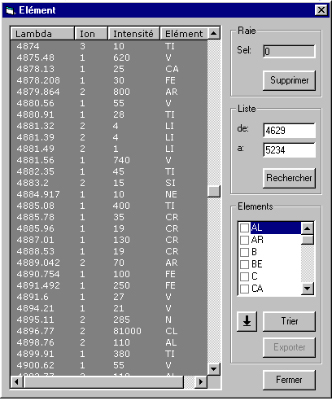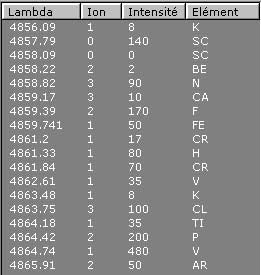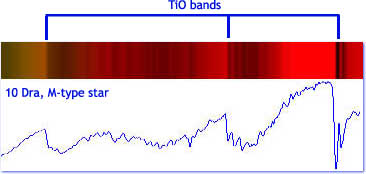
| Identify lines (part II) |
 |
Once you have calibrated a spectrum, there is a more scientific way to identify lines than by playing Sherlock Holmes to find classical lines. Each line is exactly determined by its wavelenght as it corresponds to a unique electronic transition for a given atom. In laboratory, chimist have identified and classified almost all the possible transitions and determined to which atomic element they belong to. You do this by using the "elements" feature.
|
 |
|
|
|
|
 |
Visual Spec provides you one of these databases. All the transition from elements lighter than Iron are listed with their wavelenght. By dragging the cursor on a line, you can look in the database to see which elements can have transition at this wavelength. Even more, by selecting an element, you can export the line spectrum and superimpose it on the star spectrum... |
|
|
 |
|
|
|
|
|
 |
|
|
Sound easy, but real life is different... There are numerous possible transition for a small range of wavelenght. This means that you will have difficulty to have a resolution high enough and calibration accurate enough to point without ambiguity to the exact line... If your pixel represents 1 nm, you can find up to 10 lines which can be there... So, desesperate ? Most of the time you can eliminate seldom elements. You need to have an idea of what type of object you are looking at. In A-type star, it will be very strange if you identify something else than Hydrogenous or Helium. |
|
|
 |
 In some case, the spectrum does not exhibit only lines but wide absorbtion band. This is produced by molecules. In some case, the spectrum does not exhibit only lines but wide absorbtion band. This is produced by molecules.

Visual Spec does not provide molecule transitions, but each time you find a new one in the litterature, you can edit the database and add all the new elements you need by yourself. |
|
|
|
|
|
|
|
 |
It is really strongly recommended to look on the web for example of spectrum of the type of object you are looking at. Specially for comets, Nova and Supernova, Quasar. They will give you, more surely, a very good help to find your way in the forest lines... |
|

![]()

![]()

![]() In some case, the spectrum does not exhibit only lines but wide absorbtion band. This is produced by molecules.
In some case, the spectrum does not exhibit only lines but wide absorbtion band. This is produced by molecules.

![]()